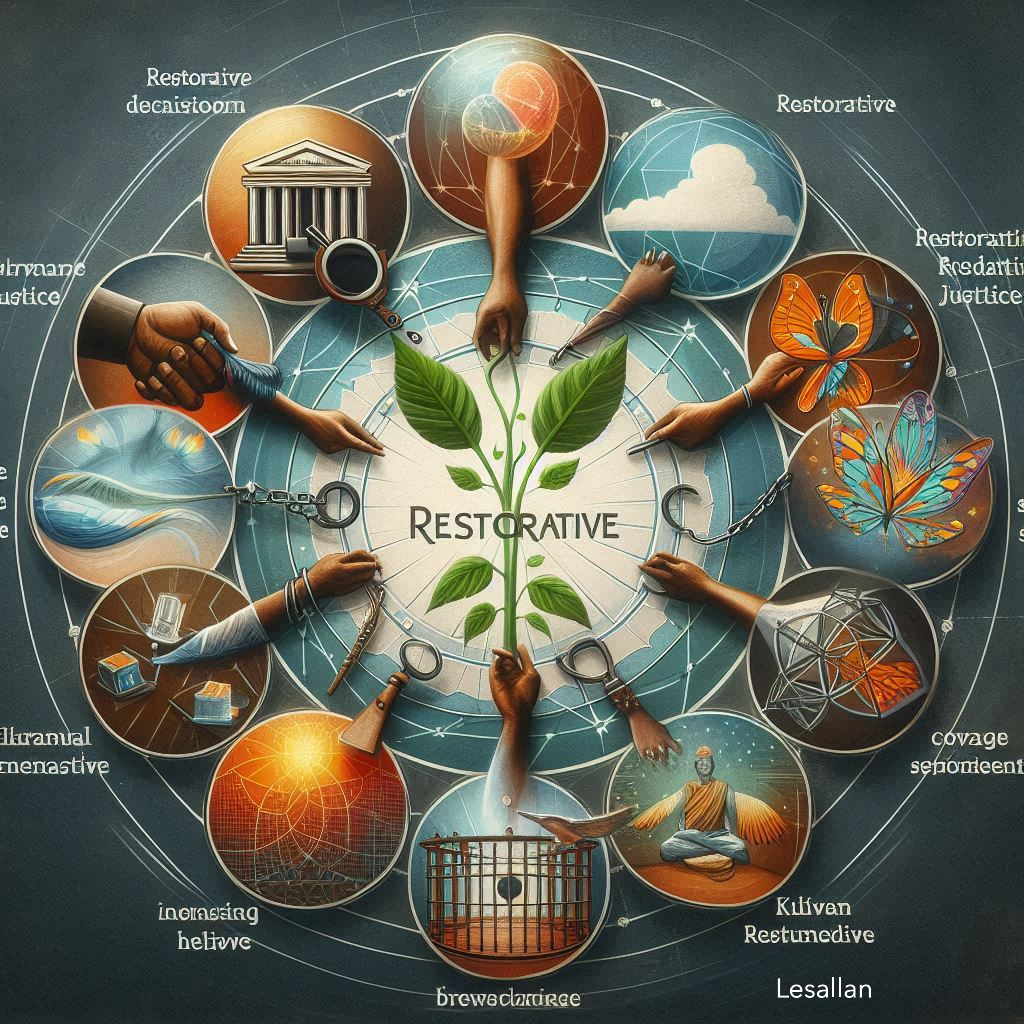August 7, 2024
Ohio Christian University
CJU1010 Introduction to Justice Systems (ONL24F1)
Dr. Denorio Quinn, Professor

Restorative Justice: A Transformative Approach
The criminal justice system employs various methods to address crimes of differing severity. However, integrating restorative justice offers a transformative approach that aligns with biblical principles. Restorative justice prioritizes repairing harm, fostering reconciliation, and addressing the diverse needs of all parties involved, including victims, offenders, and the community. The approach is based on teachings from the Bible, specifically Leviticus 6:1-7 (KJV). These teachings emphasize restitution, reconciliation, and forgiveness. The passage highlights the importance of acknowledging wrongdoing, making amends, and seeking reconciliation, which are key principles of restorative justice. According to Masters (2021), the criminal justice system must evolve to address the complexities and realities of modern society, recognizing the myths and interpreting the facts underlying the system. This study will assess the implementation of restorative justice in the criminal justice system, taking into account its adaptations according to the type and gravity of the crime and its influence on various demographic factors such as race, socioeconomic status, and gender. Additionally, it will explore how biological, psychological, and sociological factors influence restorative justice practices. This paper seeks to answer the central question: How can restorative justice be effectively incorporated into the criminal justice system to achieve its goals of punishment, rehabilitation, and reconciliation while also addressing the diverse needs of those involved?
Restorative justice practices encompass a broad spectrum of interventions tailored to the offense’s specific nature and gravity. In minor transgressions, such as petty theft or vandalism, restorative justice may entail a combination of community service, sincere apologies, and restitution, all of which facilitate the offender’s comprehension of the repercussions of their actions and their subsequent efforts to make restitution (Johnstone & Van Ness, 2007). These practices have demonstrated a consistent capacity not only to address the basic and first causes of criminal behavior but also to reduce the likelihood of reoffending and significantly enhance community confidence and social cohesion, in contrast to conventional punitive measures (Sherman & Strang, 2007). This effectiveness should reassure the audience about the possible impact of restorative justice.
More studies in the cases of severe offenses, such as assault or robbery, the application of restorative justice calls for a more elaborate and systematic procedure. This typically entails organized and facilitated discussions between the affected parties – the victims and the offenders – aimed at acknowledging the harm inflicted and formulating mutually acceptable measures for reparation and reintegration (Umbreit, 2001). Approaches such as victim-offender mediation and restorative circles have demonstrated efficacy in such scenarios by fostering empathy, a key element of restorative justice, facilitating the healing process, and promoting accountability for the aggrieved parties and those responsible for the transgressions (Zehr, 2002).
Crimes involving violence, such as homicide or sexual assault, present significant challenges to the application of restorative justice due to the nature and severity of the harm caused. Addressing such cases through restorative justice requires a nuanced approach that prioritizes the well-being of the victims and ensures that their rights are protected throughout the process (Daly, 2006). This necessitates careful handling and extensive support for the victims to mitigate the risk of re-traumatization and to facilitate their healing journey. The complex emotional and psychological impact of such crimes on the victims underscores the need for specialized care and sensitivity in the restorative justice process (Herman, 2005).
Moreover, navigating restorative justice in cases of violent crimes demands a comprehensive understanding of the intricate power dynamics, trauma, and the need for emotional safety and security for all parties involved (Coker, 2002). Empowering victims through their participation in the process and providing them with a platform to voice their experiences and express their needs can contribute to Text: Empowering individuals with a sense of agency and control over their narratives is a crucial aspect (Koss, 2000). Restorative justice, in certain cases, can provide a potential avenue for resolution and empowerment for victims, enabling them to regain a sense of justice and agency following a traumatic experience (Zehr, 2002). Through open and meaningful dialogue with the perpetrators, victims may have the opportunity to have their experiences acknowledged and validated, thereby fostering a sense of closure and healing (Umbreit, 2001). It is also essential to recognize that the successful application of restorative justice in cases of violent crimes hinges upon the willingness of the perpetrators to take genuine accountability for their actions and actively engage in making amends (Braithwaite, 2002). Emphasizing the importance of acknowledging the harm caused and fostering a genuine commitment to rehabilitation, restorative justice can inspire perpetrators to confront the consequences of their actions and actively work towards repairing the damage they have inflicted (Sherman & Strang, 2007). This, in turn, can restore a sense of balance and well-being within the community and facilitate the reintegration of the perpetrators as responsible and empathetic members of society (Johnstone & Van Ness, 2007).
Restorative justice, as a pivotal component of criminal justice reform, necessitates a nuanced adaptation to accommodate the distinctive needs of diverse demographic groups (Daly, 2006). Mitigating racial disparities inherent in the criminal justice system demands the integration of culturally competent restorative practices characterized by the meaningful engagement of community leaders and an initiative-taking approach to addressing systemic biases (Coker, 2002). For instance, the involvement of African American and Native American community leaders in the therapeutic process can potentially ensure the cultural relevance and efficacy of the practices (Koss, 2000). This inclusion acknowledges these communities’ historical and cultural context and fosters an environment conducive to equitable and restorative justice (Herman, 2005).
Socioeconomic status also plays a crucial role, as individuals from lower-income backgrounds may have less access to restorative justice programs (Braithwaite, 2002). Ensuring equitable resources and support is essential for the success of these programs. This includes financial assistance for participating in restorative justice programs and ensuring all community members access these resources (Johnstone & Van Ness, 2007).
Gender-specific issues, such as domestic violence, require gender-sensitive approaches that prioritize the safety and empowerment of victims (Coker, 2002). Restorative justice practices in these cases must be carefully designed to avoid re-traumatizing victims and ensure their voices are heard and respected (Koss, 2000). Media influence can shape public perception of restorative justice, highlighting the need for positive media engagement to build support for these practices (Herman, 2005).
Biological factors play a crucial role in the effectiveness of restorative justice, especially mental health conditions (Daly, 2006). Addressing the needs of offenders with such conditions requires the provision of comprehensive mental health support and accommodations (Sherman & Strang, 2007). This involves ensuring access to counseling, medication, and other mental health services as integral components of the therapeutic justice process (Umbreit, 2001). It is imperative to recognize and account for the impact of mental health conditions on offenders’ ability to engage with and benefit from restorative justice programs, thereby emphasizing the significance of incorporating tailored support mechanisms into these processes.
Considering the psychological factors at play, it is imperative to acknowledge and address the trauma experienced by both the victims and offenders when engaging in restorative practices. This approach should be aimed at promoting healing and reconciliation, as noted by Herman (2005). Adhering to trauma-informed care principles is fundamental in the context of restorative justice, ensuring that all parties’ needs are adequately met and that the process does not inadvertently inflict additional harm, as Koss (2000) emphasized.
Sociological factors, such as family dynamics and community support, play a vital role in the success of restorative justice (Braithwaite, 2002). Engaging families and communities in the therapeutic process can enhance effectiveness and sustainability (Johnstone & Van Ness, 2007). This includes involving family members in restorative circles and providing community support networks to help reintegrate offenders (Umbreit, 2001).
Balancing restorative justice with traditional punitive measures is essential for a comprehensive approach to justice (Zehr, 2002). Hybrid models that combine punishment and restoration can achieve a balanced approach, ensuring accountability while promoting healing and rehabilitation (Sherman & Strang, 2007). For example, offenders may be required to complete community service or attend rehabilitation programs as part of their therapeutic justice agreement (Johnstone & Van Ness, 2007). This balanced approach provides reassurance and confidence in the effectiveness of restorative justice (Braithwaite, 2002).
In summary, implementing restorative justice within the criminal justice system presents opportunities to address the diverse needs of victims, offenders, and the community. By recognizing the varying degrees of harm caused by different offenses and the complex dynamics at play, restorative justice can contribute to reconciliation, rehabilitation, and a sense of equity. However, it is crucial to approach the application of restorative justice with sensitivity and responsiveness to each case’s unique circumstances, particularly in severe or violent crimes. Further research and ongoing evaluation of restorative justice practices will be essential in refining its implementation and ensuring that it effectively serves the overarching goals of the criminal justice system.
References:
Braithwaite, J. (2002). Restorative justice and responsive regulation. Oxford University Press.
Coker, D. (2002). Transformative justice: Anti-subordination processes in cases of domestic
violence. In H. Strang & J. Braithwaite (Eds.), Restorative justice and family violence (pp. 128–152). Cambridge University Press.
Daly, K. (2006). The limits of restorative justice. In D. Sullivan & L. Tifft (Eds.), Handbook of
Restorative justice: A global perspective (pp. 134–145). Routledge.
Herman, J. L. (2005). Trauma and recovery: The aftermath of violence–from domestic abuse to
political terror. Basic Books.
Johnstone, G., & Van Ness, D. W. (2007). Handbook of restorative justice. Willan Publishing.
Koss, M. P. (2000). Blame, shame, and community: Justice responses to violence against women.
American Psychologist, 55(11), 1332–1343.
Masters, R. (2021). CJ: realities and challenges. Mcgraw-Hill Education.
Sherman, L. W., & Strang, H. (2007). Restorative justice: The evidence. The Smith Institute.
Umbreit, M. S. (2001). The handbook of victim offender mediation: An essential guide to
practice and research. Jossey-Bass.
Zehr, H. (2002). The little book of restorative justice. Good Books.




6 Comments
Amelia Collins · August 10, 2024 at 5:09 pm
So good
Kalorifer Sobası · August 11, 2024 at 11:07 am
Thank you for the auspicious writeup It in fact was a amusement account it Look advanced to far added agreeable from you However how can we communicate
Lily Hughes · August 12, 2024 at 3:25 pm
This post is a valuable addition—thank you!
temp mail · August 16, 2024 at 2:03 am
I loved as much as you will receive carried out right here The sketch is attractive your authored material stylish nonetheless you command get got an impatience over that you wish be delivering the following unwell unquestionably come more formerly again since exactly the same nearly a lot often inside case you shield this hike
Temp Mail · August 18, 2024 at 5:34 pm
I share your level of enthusiasm for the work you’ve produced. The sketch you’ve displayed is refined, and the material you’ve authored is impressive. Nevertheless, you seem anxious about the prospect of heading in a direction that could cause unease. I agree that you’ll be able to address this concern in a timely manner.
TMail · August 18, 2024 at 6:45 pm
The degree to which I appreciate your creations is equal to your own sentiment. Your sketch is tasteful, and the authored material is stylish. Yet, you seem uneasy about the prospect of embarking on something that may cause unease. I agree that you’ll be able to address this matter efficiently.
Comments are closed.